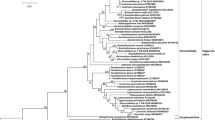Abstract
The genus Hemicaloosia is one of two genera belonging to the family Caloosiinae Siddiqi, 1980. Species in this genus are obligate ectoparasites of plants with only ten described species worldwide. In this study, we provide the first report of a Hemicaloosia species from Vietnam and compare it to other Hemicaloosia species from the world using morphology, morphometrics, Cluster analysis, and MDS analysis. All comparisons clearly indicate that our nematode population belongs to H. guangzhouensis. Our study provided more measurement indices to support the diagnosis of H. guangzhouensis, suggested the synonymisation of H. vagisclera, H. delpradi, and H. americanae, and revealed two incorrect identifications (including the population of Caloosia shorai from India and the population of H. luci from Brazil). Besides, this is also the first report of the genus Hemicaloosia in Vietnam.


Similar content being viewed by others
References
Anderson MJ, Gorley RN, Clarke KR (2008) PERMANOVA+ for PRIMER: Guide to software and statistical methods. UK
Andrássy I (2007) Free-living Nematodes of Hungary (Nematoda Errantia) II. Hungarian Natural History Museum and Systematic Zoology Research Group of the Hungarian Academy of Sciences, Budapest
Brzeski MW (1974) Taxonomy of Hemicycliophorinae (Nematoda, Tylenchida). Zeszyty Problemowe Postepow Nauk Rolniczych 154:237–330
Chaves E (1983) Criconematoidea (Nematoda) from Argentina. Nematologica 29:404–424
Chitambar JJ, Subbotin SA (2014) Systematics of the sheath nematodes of the superfamily Hemicycliophoroidea. Brill, Netherlands https://doi.org/10.1163/9789004187894
Colbran RC (1963) Studies of plant and soil nematodes. 6. Two new species from citrus orchards. Queensl J Agric Sci 20:469–474
Cordero López MA, Robbins RT, Szalanski AL (2013) Taxonomic and molecular identification of Hemicaloosia, Hemicycliophora, Gracilacus and Paratylenchus species (Nematoda: Criconematidae). J Nematol 45:145–171
Costa Manso E (1996) Studies on the subfamily Hemicycliophorinae (Nematoda: Criconematoidea). Fitopatol Bras 21:197–218
Courtney WD, Polley D, Miller VL (1955) TAF, an improved fixative in nematode technique. Plant Disease Report 39:570–571
Dhanachand C, Jairajpuri MS (1979) Hemicriconemoides neobrachyurus sp. n. and Hemicaloosia luci sp. n. (Nematoda: Criconematoidea) from Manipur, India. Ind J Nematol 9:111–116
Gambhir RK, Dhanachand C (1996) Nematodes of fruit plants in Manipur - five new species of tylenchids (Nematoda: Tylenchida). Ind J Nematol 26:197–207
Geraert E (2010) The Criconematidae of the world: identification of the family Criconematidae (Nematoda). Academia Press, Ghent. https://doi.org/10.1163/156854111X620497
Inserra R, Stanley J, Troccoli A, Chitambar J, Subbotin S (2013a) Disregarding ZooBank registration results in the unavailability of Hemicaloosia graminis Zeng et al., 2012 (Nematoda, Tylenchida) under the ICZN code. ZooKeys 309:71–73. https://doi.org/10.3897/zookeys.309.5532
Inserra RN, Stanley JD, Troccoli A, Chitambar J, Subbotin SA (2013b) Hemicaloosia vagisclera n. sp. (Nematoda: Caloosiidae) from Bermuda grass in Florida and its phylogenetic relationships with other criconematids. Nematology 15:23–39. https://doi.org/10.1163/156854112X643725
Luc M (1958) Trois nouvelles espèces africaines du genre Hemicycliophora de Man, 1921 (Nematoda. Criconematidae). Nematologica 3:15–23
Maas PWT (1970) Tentative list of plant parasitic nematodes in Surinam, with descriptions of two new species of Hemicycliophorinae. Bull Landbouwproefstation Suriname 87:1–9
Nguyen NC (2003) Plant-parasitic nematodes and control base (in Vietnamese). Science and Technics Pulishing House, Hanoi
Pramodini M, Mohilal N, Gambhir RK (2007) Criconemella lobella sp. n. and Caloosia langolus sp. n. from lemon plants of Manipur. Flora and Fauna (Jhansi) 13:433–438
Raski DJ, Luc M (1987) A reappraisal of Tylenchina (Nemata). 10: the superfamily Criconematoidea Taylor, 1936. Rev Nématol 10:409–444
Ray S, Das SN (1978) Hemicaloosia americana n. gen., n. sp. (Nematoda: Hemicycliophoridae) from Orissa, India. OUAT J Res 8:131–138
Seinhorst JW (1959) A rapid method for the transfer of nematodes from fixative to anhydrous glycerin. Nematologica 4:67–69. https://doi.org/10.1163/187529259x00381
Siddiqi MR (1980) Taxonomy of the plant nematode superfamily Hernicycliophoroidea, with a proposal for Criconematina, new suborder. Rev Nématol 3:179–199
Siddiqi MR (1986) Tylenchida: parasites of plants and insects. Commonwealth Agricultural Bureaux, Slough
Siddiqi MR (2000) Tylenchida: parasites of plants and insects, 2nd edn. CABI, Wallingford
Van Den Berg E, Tiedt LR, Subbotin SA (2011) Morphological and molecular characterisation of Caloosia longicaudata (Loos, 1948) Siddiqi & Goodey, 1963 (Nematoda: Caloosiidae) from Maui, the Hawaiian islands with notes on some species of the genus. Nematology 13:381–393. https://doi.org/10.1163/138855410X528947
Wang K, Li Y, Xie H, Wu WJ, Xu CL (2016) Morphological and molecular characterisation of Hemicaloosia guangzhouensis n. sp. (Nematoda: Caloosiidae) from China. Eur J Plant Pathol 144:497–507. https://doi.org/10.1007/s10658-015-0790-9
Whitehead AG, Hemming JR (1965) A comparison of some quantitative methods of extracting small vermiform nematodes from soil. Ann Appl Biol 55:25–38. https://doi.org/10.1111/j.1744-7348.1965.tb07864.x
Zeng Y, Ye W, Tredway L, Martin S, Martin M (2012) Description of Hemicaloosia graminis n. sp. (Nematoda: Caloosiidae) associated with turfgrasses in north and South Carolina, USA. J Nematol 44:134–141
Acknowledgments
This research was supported by the the Institute of Ecology and Biological Resources, Vietnam Academy of Sciences and Technology (project code: VAST04.08/22-23).
Author information
Authors and Affiliations
Corresponding authors
Ethics declarations
The result of this work has not been published previously and is not under consideration elsewhere.
Conflict of interest
The authors declare that they have no conflict of interest.
Additional information
Publisher’s note
Springer Nature remains neutral with regard to jurisdictional claims in published maps and institutional affiliations.
Rights and permissions
Springer Nature or its licensor (e.g. a society or other partner) holds exclusive rights to this article under a publishing agreement with the author(s) or other rightsholder(s); author self-archiving of the accepted manuscript version of this article is solely governed by the terms of such publishing agreement and applicable law.
About this article
Cite this article
Nguyen, T.D., Nguyen, H.T., Le, T.M.L. et al. Characterisation of Hemicaloosia guangzhouensis and a first report of the genus Hemicaloosia (Nematoda: Criconematina) from Vietnam. Biologia 78, 2819–2826 (2023). https://doi.org/10.1007/s11756-023-01417-3
Received:
Accepted:
Published:
Issue Date:
DOI: https://doi.org/10.1007/s11756-023-01417-3




